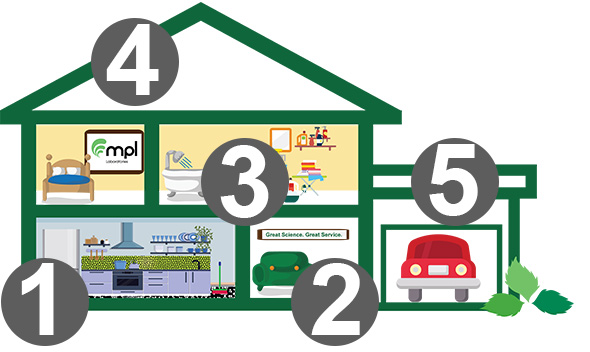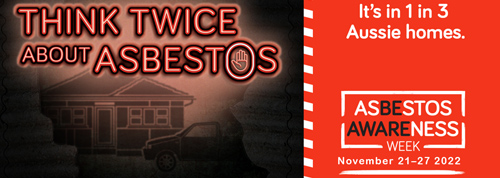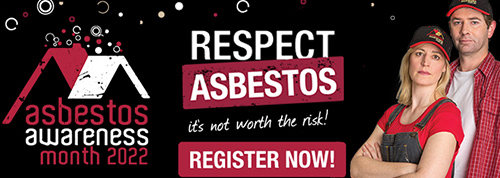The dangers of asbestos exposure appear to be well known, but many tradies and DIYers are still either overly casual when it comes to handling materials containing asbestos or don’t realise what they are and the possible places they may be lurking.
November is National Asbestos Awareness Month (NAAM) with the last week of November (Nov 21-27, 2022), being recognised as National Asbestos Awareness Week (NAAW). Why so much attention? The importance of these campaigns cannot be overstated. Given Australia was historically one of the highest users of asbestos worldwide and that asbestos continues to remain hidden in one in three Australian homes, this hazardous substance should not be ignored and it’s important that homeowners and renovators are aware of how to safely manage asbestos in and around the home every day of the year.
What is asbestos and why is it still a problem in 2022?
Asbestos, a fibrous silicate mineral, is a general name given to a group of six different minerals made up of fibres and occurring naturally in the environment. Useful for its high chemical resistance, mechanical resistance and its insulating capacity, this mineral was extensively used in the building and industrial sectors during the twentieth century. Asbestos Containing Materials (ACM) are classified as either friable (soft, crumbly or loose fibres) or non-friable (bonded or solid).
Non-friable asbestos generally cannot be crumbled or pulverised into powder when dry, and was commonly used in building materials including fibro, corrugated or compressed asbestos cement sheets as well as water piping and flue pipes. Where fibro or other bonded asbestos sheeting is broken, damaged over time by 'wear and tear' or mishandled by other means, fibres can become loose and airborne, thus posing a risk.
Friable asbestos is any material containing asbestos in the form of a powder or can be crumbled by hand pressure. Considered as the more dangerous of the two varieties, friable asbestos was mainly used in industrial applications and was also sometimes used as ceiling insulation.
Phased out in the 1980s and eventually banned in mining, manufacturing and use in Australia in 2003 as the dangerous and cancerous effects of asbestos become known, does not mean that asbestos is no longer relevant or a thing of the past. Based on its widescale historic use and that asbestos fibres cannot be broken down easily by chemicals or bacteria, asbestos and ACM continue to remain in many workplaces and homes around Australia. In the home, asbestos can be found in wall sheeting of wet areas, such as in the kitchen, bathroom and laundry. Other internal locations include carpet underlays, linoleum and vinyl tiles, drains and electrical meter boards, ceiling space (insulation). Outside the home, it’s still lurking around - garages, roofs, eaves, around hot water pipes and boiler insulation, fences, garages, outdoor toilets, garden sheds, backyard and farm structures, chook sheds and even dog kennels! This hazardous material can also be found in brakes, clutches, and gaskets.
Potential locations of asbestos in the home

Many buildings, especially older properties, may today have asbestos or ACM. The diagram shows some areas where asbestos or ACM potentially can be located. Risk to health is low if left undisturbed or unlikely that airborne asbestos fibres will be released. Importantly, you will not be able to discover asbestos by simply looking at it - always verify with a NATA Accredited lab!
1 Kitchen
Vinyl floor tiles, backing of floor covering, splashbacks, hot water pipes and stove insulation.
2 Living areas
Carpet underlay, wall and ceiling panels, wood heater insulation and beneath wood heater hearths.
3 Bathroom and laundry
Wall and ceiling panels, vinyl floor tiles and backing, toilet cisterns, hot water pipes and lagging.
4 Roofing
Roof sheeting, chimney flues, lining under eaves, gutters, ridge capping, downpipes and imitation brick cladding.
5 External and other
Garage, sheds, automobiles and boat parts, textured paint, dog kennels, adhesives and dumped waste.
The Australian Border Force (ABF) indicates risk of imported building materials and other products entering Australia as asbestos is not banned in some countries. Even imported children's crayons and car parts have come under the ABF's scrutiny. Despite these ongoing challenges, the Australian Government remains focused on eliminating imported asbestos. Resources for importers and exporters are available through the Asbestos Safety and Eradication Agency.
What are the health risks?
Asbestos fibres are too small to see with the naked eye, but they are still dangerous. The World Health Organization states there is no safe level of exposure to asbestos fibres. When the material is disturbed, fibres can become airborne. Inhalation of these fibres can result in serious diseases such as mesothelioma, asbestosis and lung cancer. These asbestos-related diseases may have long latency period, which means the disease usually does not develop until years after the asbestos exposure that caused it. An estimated 4,000 Australians die annually from asbestos-related diseases, which is nearly four times the annual road toll, and asbestos is still present in millions of homes, as well as public and commercial buildings. As long as asbestos-containing materials remain in homes built or renovated prior to 1990, it’s vital that DIYers, homeowners, renovators and tradies heed the warnings and learn to respect the serious dangers of asbestos to help save lives.
Employers also have a responsibility to determine whether asbestos is present in the workplace. The WHS Act and Regulations place obligations and legal duties on the ‘person who conducts a business or undertaking’ (PCBU), officers and workers to make sure workplaces are safe. Tradespeople are advised to have the property or suspected material assessed by a qualified occupational hygienist or other suitably qualified professional if they do not have the equipment, skills, training or a licence to handle asbestos. If in doubt, treat the suspect material as though it does contain asbestos.
Detecting asbestos: don't assume asbestos is not present, assume it is
You can’t tell if a material contains asbestos just by looking at it. Only scientific testing of a sample at a NATA Accredited laboratory can confirm this. If you suspect a material might contain asbestos, play it safe and treat it like it is until you’ve had it confirmed. MPL Laboratories holds ISO/IEC 17020 NATA Accreditation for asbestos testing services with fast, same-day turn-around of results. You can be assured that MPL Laboratories will provide high quality laboratory services tailored to meet each individual situation.
Thinking about a renovation project during the summer break? Not sure where to start before doing a reno? Why not visit our asbestos services page for more information or get in touch today!
About the campaigns

National Asbestos Awareness Week (NAAW) 2022: November 21-27
NAAW, which is being held this year on the last week of November (Nov 21-27, 2022), reminds Australians to Think Twice About Asbestos. Occupiers and tradespeople are being reminded to 'do things the right way' by ensuring the proper and lawful disposal of asbestos. The campaign is organised by the Australian Government’s Asbestos Safety and Eradication Agency, in partnership with state and territory government agencies and non-government organisations.

National Asbestos Awareness Month (NAAM) 2022: November 1-30
Since 2011, the month of November has been marked as NAAM in a bid to improve education about asbestos. In 2022, home renovators are the focus, as tightening budgets around strains in the cost of living and a general shortage of tradespeople are seeing more homeowners turn to DIY. The campaign had Federal Government funding until 2018. Since 2021, Asbestos Awareness has been run pro bono by an independent Asbestos Education Committee comprised of experts across health, government, industry and victims of asbestos-related diseases and are seeking ongoing funding. Funding partners are being sought to continue providing resources including fact sheets, guides to identifying asbestos in the home and checklists for both DIYers and specific trades to identify common asbestos-containing products you’re likely to encounter and where you’ll find them.
#DIY #Renovating #Renovations #RespectAsbestos #AsbestosAwareness #AsbestosAwarenessMonth #RenovationRoulette #AsbestosSafety #StopPlayingRenovationRoulette #RespectAsbestosRisks #AsbestosAndRenovating